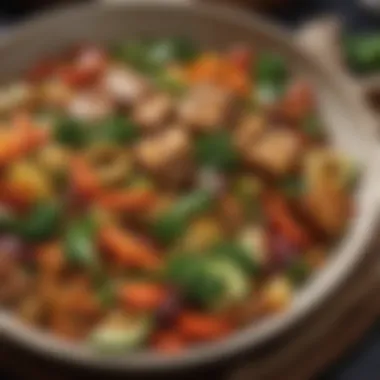Exploring Seitan: The Versatile Vegan Protein Source


Intro
In recent years, seitan has emerged as a prominent source of plant-based protein, captivating both seasoned cooks and novice enthusiasts. Often referred to as wheat meat, seitan offers a compelling alternative to traditional animal proteins. It's made primarily from wheat gluten, enabling it to take on a meaty texture and absorb flavors exceptionally well.
This article explores the intricate world of seitan, focusing on its nutritional profile, culinary potential, and overall health implications. Whether you are looking to diversify your vegan diet or simply experiment with new ingredients, understanding how to prepare and incorporate seitan into your meals can elevate your culinary experience.
From detailed preparation methods to innovative uses in various dishes, readers will find valuable insights into this versatile ingredient. As interest in plant-based diets continues to grow, so does the significance of seitan in diets around the world. The following sections will dissect its components and provide guidance on how to harness its benefits effectively.
Understanding Seitan
Understanding seitan is central to appreciating its role in the vegan culinary landscape. Being derived from wheat gluten, seitan offers a unique protein source for people following plant-based diets. It has gained popularity for its texture and versatility, often serving as a meat substitute in meals. This section explains what seitan is, traces its historical context, and examines its nutritional value. Through this exploration, readers will grasp why seitan is integral for both novice and experienced cooks pursuing a rich, plant-based meal experience.
What is Seitan?
Seitan is a food product made by washing wheat flour dough with water to remove starch granules. The result is a sticky, gluey mass of gluten proteins. This mass can be cooked and seasoned in various ways, leading to a range of textures and flavors. Seitan's unique structure allows it to absorb flavors well, making it a popular choice for many recipes. It stands out as a highly sought-after source of plant-based protein, particularly in dishes designed to mimic the taste and feel of meat.
History of Seitan
The usage of seitan dates back hundreds of years. Originally from Asia, it has roots in Chinese Buddhism, where monks used it as a meat alternative. It was known as "buddha's delight" and was a staple during vegetarian diets in religious practices. Over time, seitan made its way to Japan, where it became known as "fu" or "wheat meat." In more recent years, as veganism gained momentum globally, seitan has witnessed a resurgence, becoming a common ingredient in both home kitchens and professional kitchens worldwide. The expanding interest in plant-based diets has re-introduced this historical staple to a modern audience.
Nutritional Profile of Seitan
Seitan is notable for its nutritional profile, which varies based on how it is prepared and what additional ingredients are used.
Protein Content
The protein content of seitan is extremely high. In fact, it contains approximately 25 grams of protein per 3.5 ounces, making it one of the richest plant-based protein sources available. This characteristic is fundamental for those seeking to increase protein intake while adhering to a vegan diet. The presence of protein makes seitan an attractive option compared to other plant proteins, such as lentils or chickpeas, which have considerably lower protein percentages.
Amino Acids
However, the amino acid profile of seitan is less comprehensive. While it is high in protein, seitan lacks some essential amino acids, particularly lysine. This limitation means that while seitan is a strong protein source, it should ideally be paired with other protein-rich foods to achieve a balance of all essential amino acids. Therefore, it is essential to consider this when integrating seitan into a well-rounded vegan diet, ensuring that one incorporates varied protein sources.
Caloric Value
Seitan has a moderate caloric value – about 140 calories per 3.5 ounces, which is lower than many meat options, such as beef or chicken. This makes it a popular choice for those looking to maintain or reduce calorie intake while still getting significant protein. The caloric value of seitan also allows it to be part of a calorie-controlled diet, making it an excellent fit for various dietary needs, such as weight maintenance or loss.
Seitan has emerged as a major player in the plant-based protein scene due to its high protein content and versatility, yet understanding its nutritional limitations is crucial for creating balanced meals.
Culinary Uses of Seitan
Seitan, often termed as wheat meat, offers a vast range of culinary possibilities. This section addresses the significance of seitan in diverse recipes, particularly in plant-based cooking. Its texture mimics that of meat, making it an ideal substitute. This versatility opens up numerous avenues for creativity in the kitchen. Each preparation method brings out different flavors and textures of seitan, making it an essential ingredient for vegans and vegetarians alike.
Common Preparations
Stir-Frying
Stir-frying is a quick cooking technique that showcases seitan's adaptability. It typically involves cooking thin pieces of seitan over high heat, often with vegetables and a sauce. This method enhances the texture, resulting in a crispy exterior with a tender inside. Stir-frying is popular because it allows for rapid cooking, preserving the nutrients in the ingredients. Moreover, it requires minimal oil, keeping the dish healthy. The downside might be that if not done correctly, it can lead to uneven cooking, where some pieces become chewy.
Grilling
Grilling seitan brings a smoky flavor that is often reminiscent of barbecued meat. This preparation involves cooking seitan on a grill until it's charred, which contributes a unique taste to the dish. Grilled seitan can be used in sandwiches, salads, or served as a main dish.


The key characteristic of grilling is its capacity to impart distinct flavors through caramelization. This method is favored for outdoor cooking. However, one needs to watch the cooking time carefully, as overdoing it can result in tough pieces.
Baking
Baking seitan can yield a rich and hearty meal. This method involves seasoning and wrapping seitan in parchment before placing it in the oven. Baking allows seitan to absorb flavors from herbs and spices, producing a deep enigma of taste.
The benefit of baking is its ease of preparation, freeing the cook for other tasks while the dish cooks. Additionally, it allows for more complex flavor profiles. A disadvantage here is that the cooking time is longer compared to other methods, requiring planning in meal preparation.
Seitan in Different Cuisines
Asian Cuisine
In Asian cuisine, seitan shines as a versatile protein source, often used in stir-fries, curries, and soups. Its ability to absorb flavors makes it a favorite in dishes like vegan pho or pad thai. The vibrant seasoning in Asian cooking complements seitan perfectly.
Asian cuisine emphasizes balance and freshness, which aligns well with seitan's texture. This adaptability also encourages creativity in flavor profiles. However, some dishes might rely heavily on sauces that could contain high sodium, which the health-conscious need to consider.
Western Dishes
Seitan has gained popularity in Western food traditions, often featured in comfort food dishes. Examples include seitan burgers, tacos, and stews. The key feature here is its versatility in replicating familiar flavors of traditional meat dishes.
Western dishes benefit from seitan's dense texture, providing satisfaction without the meat. However, there may be a challenge in achieving the same level of tenderness that one might find with animal proteins, which can influence overall enjoyment.
Latin American Inspirations
Latin American cuisine utilizes seitan in innovative ways, transforming it into meat alternatives for tacos, enchiladas, and even empanadas. The rich flavors inherent in Latin dishes harmonize well with seitan, allowing for bold taste combinations.
This culinary application signifies a growing trend towards inclusivity in plant-based diets, offering hearty meals that don't compromise on flavor. Nonetheless, cumulative reliance on processed seasonings can lead to dietary imbalances, which should be monitored.
Creating Homemade Seitan
Basic Recipe
Creating seitan at home simplifies the control over ingredients and flavors. The basic recipe typically includes vital wheat gluten, water, and seasonings to create a firm, elastic dough. This not only promotes freshness but also encourages customization.
The primary advantage of a homemade recipe is the ability to adjust flavors and textures according to personal preferences. A common disadvantage is that the texture can vary, potentially leading to less satisfactory outcomes than store-bought options.
Flavoring Techniques
Flavoring techniques enhance the taste of seitan during preparation. Common methods include marinating in sauces, using strong herbs, or boiling in broth before cooking. This approach allows for detailed manipulation of flavors.
The key trait of flavoring is its impact on making seitan more appealing, helping integrat it into various dishes. However, an overemphasis on strong flavors might overshadow the seitan's natural taste.
Storage and Shelf Life
Understanding the storage and shelf life of seitan is crucial for meal planning. Properly stored, homemade seitan can last up to a week in the refrigerator or can be frozen for longer periods. This aspect makes it a practical choice for meal prep.
The significant characteristic of seitan's shelf life is its versatility for convenience, allowing cooked meals to be readily available. However, it’s essential to monitor for spoilage, especially if not vacuum sealed, as this can lead to waste.
Health Considerations
Health considerations surrounding seitan are integral to understanding its role in diets, especially for those following vegan or vegetarian lifestyles. Seitan, primarily made of wheat gluten, is popular among those seeking to increase their protein intake without animal products. However, various aspects need to be assessed, such as its benefits, potential downsides, and allergy considerations.
Benefits of Incorporating Seitan


Source of Protein
Seitan is a remarkable source of protein. It contains about 25 grams of protein per 100 grams, which provides substantial nutritional support. This high protein content is particularly useful for vegans who often struggle to find high-protein plant sources. Due to its strong amino acid profile, seitan appeals to many vegetarians and health-conscious eaters. The unique feature of its protein content is that it closely mimics the protein levels found in chicken or beef. This makes seitan an effective option for those limiting animal consumption yet needing protein-dense foods in their meals.
Low in Carbohydrates
Seitan is low in carbohydrates. This is an important characteristic for individuals following low-carb diets, such as keto or paleo. Unlike many plant proteins, seitan allows for maintaining a lower carb intake while still achieving protein goals. This balance is essential for those targeting specific dietary strategies. The unique feature here is that seitan serves as a satisfying staple, without the carbohydrate load typical of grains and legumes.
Versatile Ingredient
Seitan’s versatility as an ingredient sets it apart. It adopts various flavors and textures based on cooking methods and seasonings. Its chewy texture can resemble the mouthfeel of meat, making it ideal for stir-fries, stews, or even sandwiches. This quality allows seitan to be used in worldwide cuisines, encouraging creativity in meal planning. Its adaptability is a major advantage when considering food variety in a plant-based diet.
Potential Downsides of Seitan
Wheat Gluten Sensitivity
Wheat gluten sensitivity is a significant concern for some individuals. With seitan composed mainly of gluten, those with sensitivity or intolerance may experience digestive issues or discomfort. This specific aspect highlights why it’s crucial to recognize individual dietary needs. The disadvantage is that while seitan is beneficial for many, it can lead to adverse effects in a vulnerable population.
Nutritional Balance
Maintaining nutritional balance is necessary when incorporating seitan into the diet. While it is rich in protein, seitan lacks certain nutrients, such as fiber and various vitamins typically found in whole grains and legumes. This could lead to deficiencies if seitan becomes a primary protein source without complementary foods. The key here is ensuring a well-rounded diet that incorporates diverse nutrients for overall health.
Excess Sodium
In many commercially prepared seitan products, excess sodium can be an issue. It is often seasoned for flavor enhancement, leading to high sodium levels that could pose health risks. Individuals monitoring salt intake for hypertension or heart health should scrutinize labels. This aspect presents a disadvantage, as high sodium intake can lead to adverse health effects over time.
Seitan and Allergies
Understanding Gluten Allergies
Understanding gluten allergies is crucial. For those with celiac disease, ingestion of gluten leads to severe health consequences. Recognizing this aspect ensures awareness when choosing food options. Highlighting gluten allergies emphasizes the importance of avoiding seitan for those affected and encourages them to seek alternatives.
Alternatives to Seitan
With seitan not suitable for everyone, it is essential to explore alternatives. Options like tofu, tempeh, or legumes can provide adequate protein and nutrients without gluten. Each alternative has its own set of benefits and textures that can fill the gap left by seitan. Considering these alternatives allows individuals to find satisfying substitutes while adhering to dietary restrictions.
Seitan in a Vegan Diet
Seitan is often heralded for its distinct role in a vegan diet. Due to its high protein content and meat-like texture, it serves as a compelling alternative to animal proteins. The incorporation of seitan not only addresses protein needs but also enhances the variety in a plant-based diet. Incorporating seitan effectively can support overall health and culinary creativity.
Integrating Seitan into Meal Plans
Daily Nutritional Goals
Balancing daily nutritional goals is crucial for those on a vegan diet. Seitan stands out due to its impressive protein profile, containing about 25 grams of protein per 3.5 ounces. This high protein content makes it an excellent choice to help meet daily requirements without relying on animal products. However, it is vital to consider that seitan is low in other important nutrients, such as vitamins B12 and iron. Therefore, when planning meals, it is advised to complement seitan with other foods rich in these nutrients. This combination enhances its benefits and allows for a well-rounded vegan approach.
Meal Prep Ideas
Meal prep with seitan can streamline cooking processes and support consistent nutritional intake throughout the week. One method is batch-cooking seitan, allowing it to be stored in the fridge for various meals. Utilizing marinades enhances flavor and versatility. Additionally, sliced seitan can be incorporated into stir-fries, salads, or sandwiches. This flexibility allows home cooks to explore different cuisines while ensuring that their meals remain healthy and satisfying. Preparing meals in advance often yields time savings and encourages healthier eating habits.
Seitan as a Meat Substitute


Seitan's texture mimics meat quite well, making it a popular choice for those looking to reduce or eliminate animal products. It absorbs flavors from marinades and sauces effectively, enhancing the overall palatability. This characteristic allows for creative culinary applications, promoting the incorporation of seitan in traditional meat recipes, such as tacos, sausages, and even stir-fries. For many, this versatility is a key factor when choosing seitan as a staple protein source in a vegan diet.
Comparative Analysis with Other Proteins
Lentils
Lentils are a powerhouse of nutrition, offering a good balance of protein, fiber, and essential minerals. Unlike seitan, lentils are also rich in folate and iron. They are often favored for their versatility. However, lentils contain less protein than seitan, at about 9 grams per cooked half-cup. This means that while they can complement a vegan diet, they may not serve as a primary protein source on their own.
Tofu
Tofu presents another alternative, containing about 20 grams of protein per cup. It is highly available and offers a great source of calcium. Tofu is also versatile and can take on various flavors due to its absorbent nature. The main drawback is that it is soy-based, which might not suit everyone. Additionally, the texture may not appeal to those who prefer the chewy consistency of seitan.
Chickpeas
Chickpeas are renowned for their nutritional profile and culinary accessibility. With roughly 15 grams of protein per cup, they also provide fiber and essential vitamins. Chickpeas blend well in salads, stews, and can be puréed into spreads like hummus. However, their texture and flavor differ significantly from seitan. For individuals seeking a meat-like experience, chickpeas may not fully satisfy that desire but can still be an essential part of a balanced vegan diet.
Sustainability Factors
Sustainability is a critical aspect of food choices today. When it comes to seitan, evaluating its sustainability involves looking at various factors including its production methods and impact on the environment. This section will explore the importance of sustainability concerning seitan, focusing on its environmental effects and ethical considerations.
Environmental Impact of Seitan Production
The production of seitan primarily involves wheat, which has its own set of sustainability challenges. Wheat is generally regarded as a relatively sustainable crop compared to animal farming. It requires less land and water to produce protein per weight than meat does. Moreover, seitan production inherently has a smaller carbon footprint.
In terms of water usage, the cultivation of wheat generates lower water consumption rates than what is necessary for raising livestock. This leads to less strain on freshwater resources. Additionally, wheat crops can be grown in diverse climates, making it a flexible option for production.
However, it's essential to recognize the potential environmental downsides. Intensive farming practices may still contribute to soil degradation and biodiversity loss. Utilizing organic farming methods can mitigate some of these issues. Organic farming often promotes healthier soil and reduces chemical runoff into water sources, fostering a more sustainable production cycle.
Seitan and Ethical Eating
Ethical considerations in food choices extend beyond mere sustainability; they encompass welfare aspects and personal beliefs about food sourcing. For those following a vegan diet, seitan offers a compelling substitute for animal-derived proteins. This aligns with ethical eating, which advocates for minimizing harm to animals and the environment.
Choosing seitan as a protein source can reflect a commitment to ethical dietary practices. Unlike meat production, which is often associated with animal suffering and harsh farming conditions, seitan production does not involve animals. This aligns with vegan principles, promoting the reduction of animal harm in diets.
However, there are ethical discussions around wheat production and the agricultural practices involved. Some argue that all forms of agriculture can negatively impact the environment. As such, supporting sustainable farming practices is crucial. Consumers can seek out brands that prioritize ethical sourcing and environmentally friendly practices in their seitan products.
"Choosing seitan reflects a mindful, ethical approach to protein consumption that aligns with both personal health and environmental concerns."
Final Thoughts on Seitan
Seitan stands out not only as a source of protein but also as an adaptive ingredient in plant-based cooking. Understanding its versatility is essential for anyone looking to expand their dietary repertoire. This section emphasizes the different aspects of seitan and how it can be seamlessly integrated into various meals, offering both culinary enjoyment and nutritional benefits.
Future Trends in Seitan Usage
The world of food is constantly evolving, and seitan is no exception. Its popularity is growing, influenced by several trends that are tapping into the demand for plant-based options. As consumers become more health-conscious, they seek protein that aligns with their dietary preferences. Seitan, being high in protein and low in carbohydrates, meets this demand well.
Moreover, there is a noticeable shift towards environmentally sustainable food choices. As the awareness surrounding climate change increases, more people embrace plant-based diets, pushing seitan into the spotlight.
Innovations in food technology are also shaping how seitan is produced and consumed. For example, the development of new flavoring techniques and product varieties is expanding its applications within cuisines. These advancements could lead to ready-to-eat seitan products that are more accessible to everyday consumers.
"Seitan's adaptability makes it a key player in the plant-based protein market, embodying the future of vegan cuisine."
Expanding the Vegan Palette
Expanding the vegan palette with seitan allows for a diverse range of culinary experiences. Seitan's texture mimics that of meat, making it a favorable substitute for many traditional dishes. From stir-fry to barbecue, it can take on flavors from various ingredients, enhancing the overall meal experience.
Using seitan creatively can inspire individuals to explore new recipes. By experimenting with different marinades or cooking methods, one can transform a humble ingredient into a star dish. For those looking to elevate their meals, seitan opens doors to global cuisines. It bridges the gap between meat-based dishes and plant-based eating, proving that flavorful options exist for everyone.
In summary, seitan is not just a passing trend. Its rich texture, high protein content, and adaptability position it as a crucial component in both vegan and vegetarian diets. As interest in plant-based eating continues, seitan is set to become a staple on more dinner tables worldwide.







